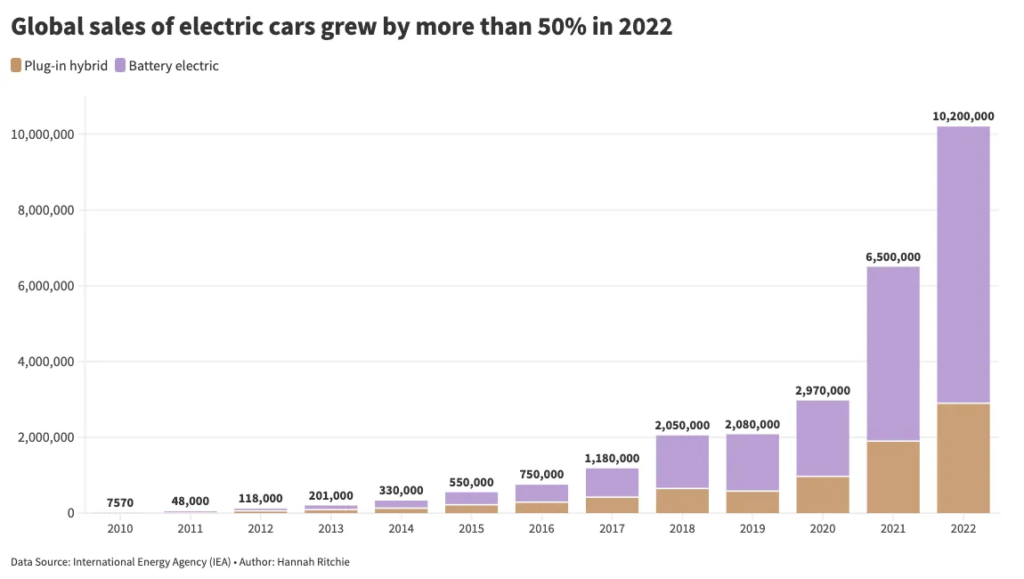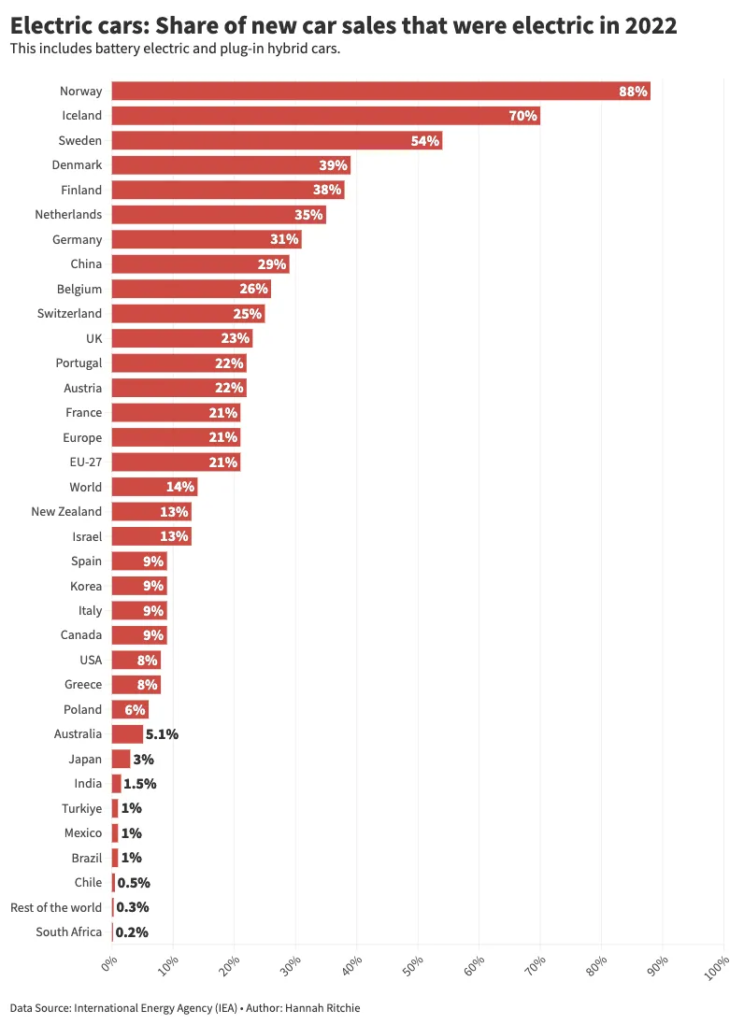In 2022, the world bought just over 10 million new electric cars. This includes battery electric and plug-in hybrids, although battery electrics dominate. The world bought 7.9 million of the former, and 2.3 million of the latter (which means that battery electric cars made up over 70% of new EV sales).
The change in global EV sales is shown in the chart below. What’s obvious is how quickly sales are rising in the space of only a few years. There was a large leap in sales in 2021, then another massive jump in 2022.
The IEA projects that sales will be over 20 million in 2030 (although I expect this is an underestimate – more on this in a future post).

How does the sale of EVs compare to petrol and diesel cars? How much of the market are they taking?
Below we see the share of new car sales that are electric. In 2022, 14% of new cars were EVs. Again, that’s a massive jump from just a few years ago. In 2020, this was just 4%.
The IEA projects that this will be 18% in 2023, and will reach almost one-in-four cars by 2025.

Europe and China are leading the way; the Americans are lagging behind
Of course, ‘14% of new sales globally’ hides the large differences in EV popularity across the world. In some countries, almost every new car is an EV; in others, EVs are almost non-existent.
In the chart, we see the share of new sales at are EVs across a range of countries.
Norway, as expected, leads the way: nearly 90% of new cars are electric. Buying a petrol or diesel car in Norway is now a rarity.
What becomes clear from the rankings is that Europe is leading the way on the EV transition. Perhaps not in terms of the absolute number of car sales (because larger countries will be selling more) but in the speed with which the market is becoming dominated by EVs. All of the top countries are European.
China is the other country where EV sales are rising quickly. In 2022, almost one-in-three (29%) of new cars sold were electric. Since matters a lot for the global trend, so I’ll zoom into China’s trend later.
The rest of the world is lagging behind. Less than 10% of new cars in the US and Canada are EVs. In Australia, this is just 5%. In Japan, just 3%. And in India, under 2% (although more than half of new three-wheelers are now electric).

For a quick snapshot of how these trends are evolving for each country, I made a quick grid view of EV sales over time. This is shown in the chart below.
You can see the stark differences in the take-off of EVs in some countries, compared to the almost non-existence in others.
We can see that in Norway, for example, sales did not just immediately jump to 90% in a few years. Norway started investing in its EV market much earlier than the rest of the world. It was already hitting reasonable sales numbers in the mid-2010s.
Norway has shown that it can be done. A key question is whether other countries can do it even faster.

China is going electric, quickly
Finally, it’s worth a quick look at the rise of EVs in China.
This matters a lot for the global trend. Not just because so many of the world’s cars are in China, but because it plays a pivotal role in manufacturing, and geopolitically, in putting pressure on other countries to respond and build their own markets.
In the chart below we see how EV sales in China have evolved. In 2022, almost one-in-three new cars were electric. That’s a big jump from the previous year: almost a doubling. And from 2020 to 2021, the share more than doubled.
China is going electric, and it’s going electric fast. Some people have claimed that this is a bad thing for climate change. China, after all, still gets a lot of its electricity from coal. Surely an EV run on coal is worse than a petrol or diesel car?
No. As I showed in a previous post, the lifetime carbon footprint of an EV where the battery is manufactured in a coal-heavy country, and where the grid electricity is coal-rich is still lower than for a gasoline car. And, here we’re talking about a car transition that will take decades. A few decades from now, China’s electricity mix will look very different. It will have decarbonised, and the climate benefits of EVs will be much greater.
Investing in an EV now is so important. We can’t – and shouldn’t – wait until our electricity grids are low-carbon before we do so.

Author: Hannah Ritchie – Founder, Substack Blog